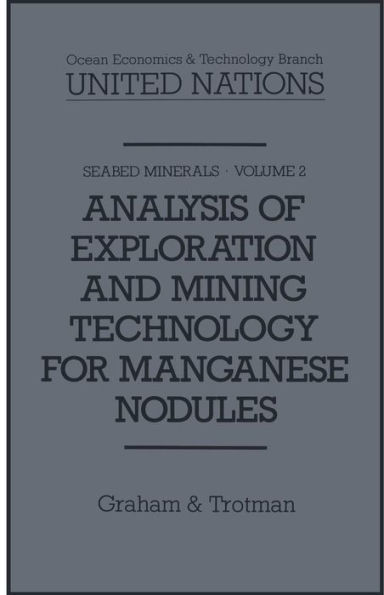Analysis of Exploration and Mining Technology for Manganese Nodules
Oceans have been the subject of scientific inquiry for hundreds of years, but significant study of mineral occurrences on the deep ocean floor has only begun to take place. Man's present knowledge of the ocean floor had to await the development of sophisticated research equipment capable of probing the ocean to great depths. This began in the 1940's and since then the accelerated pace of ocean research has generated a large amount of data on the ocean environment - mostly through the work of academic and governmental scientific organizations around the globe. These new scientific disclosures confirmed the wide-spread occurrence of metal-bearing lumps on the deep ocean floor that hold great promise as an important new source of raw material. Encouraged by these events, several groups of private, semi-private, and public enterprises became active; a transition occurred from scientific interest in the metal-bearing lumps to commercial interest. But these pioneer developers faced a formidable task. Information about the minerals and their environment of deposition was inadequate; technology for mining them continuously was non-existent and very little was known about the adaptability of processing technologies for land-based ores to these minerals.
1146073405
Analysis of Exploration and Mining Technology for Manganese Nodules
Oceans have been the subject of scientific inquiry for hundreds of years, but significant study of mineral occurrences on the deep ocean floor has only begun to take place. Man's present knowledge of the ocean floor had to await the development of sophisticated research equipment capable of probing the ocean to great depths. This began in the 1940's and since then the accelerated pace of ocean research has generated a large amount of data on the ocean environment - mostly through the work of academic and governmental scientific organizations around the globe. These new scientific disclosures confirmed the wide-spread occurrence of metal-bearing lumps on the deep ocean floor that hold great promise as an important new source of raw material. Encouraged by these events, several groups of private, semi-private, and public enterprises became active; a transition occurred from scientific interest in the metal-bearing lumps to commercial interest. But these pioneer developers faced a formidable task. Information about the minerals and their environment of deposition was inadequate; technology for mining them continuously was non-existent and very little was known about the adaptability of processing technologies for land-based ores to these minerals.
54.99
In Stock
5
1

Analysis of Exploration and Mining Technology for Manganese Nodules
144
Analysis of Exploration and Mining Technology for Manganese Nodules
144Paperback(Softcover reprint of the original 1st ed. 1984)
$54.99
54.99
In Stock

Product Details
| ISBN-13: | 9789401089807 |
|---|---|
| Publisher: | Springer Netherlands |
| Publication date: | 11/09/2011 |
| Series: | Seabed Minerals , #2 |
| Edition description: | Softcover reprint of the original 1st ed. 1984 |
| Pages: | 144 |
| Product dimensions: | 5.51(w) x 8.50(h) x 0.01(d) |
From the B&N Reads Blog
